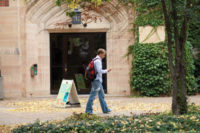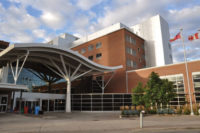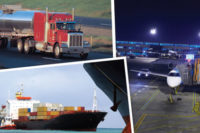Navigating the Great Outdoors


A plane flies over the Copenhagen Airport at night. The airport is using thermal imaging to protect its perimeters.
Have you ever wondered how people get away with filling their car’s gasoline tanks with and then driving off without paying? Joe Fryar, director of security for K-VA-T Food Stores, catches those gasoline thieves. K-VA-T Food Stores, Inc. is a supermarket chain with fuel centers operating in three states under the name Food City and Super Dollar.
Fryar and his staff use megapixel cameras outside of the stores to cover large areas with fewer cameras and have better video on incidents. “With our IP cameras we can better identify suspects in incidents,” he says. “We have solved numerous car burglaries and parking lot purse thefts because of the increased video clarity. On one incident we had a pharmacy robbery and the vehicle drove under our IP camera giving us a clear shot of the vehicle tag area. We also use IP cameras at our fuel centers, which allows us to have good video of the customer transaction, including the vehicle tag numbers for fuel drive offs.
And our video is constantly used for ID purposes on fraudulent check cases as the suspects are readily identifiable because of the picture clarity.” Last, but not least, on a recent robbery inside the store, the suspect was wearing a mask, but the tattoo on his arm was identifiable and was tied him as evidence.
Fryar is also replacing proprietary DVRs and analog cameras with a video management software system running on standard servers. The video management system was also integrated with MICROS Prevention software, which is an exception-based loss prevention system that helps him to quickly identify, track and respond to store events.
The bottom line: Fryar is securing areas inside, but also outside of the stores, which puts a huge variable in potential success rates. That variable would be Mother Nature.
Wind, rain, complete darkness. Securing outdoor areas can pose many challenges. Not only must equipment be weather resistant; it also should be able to distinguish a human intruder from animals and environmental conditions such as wind, rain, extreme humidity and other harsh environments. Oh, and they have to look good as well.
For Franklin & Marshall College in Lancaster, Pa., a surveillance system had to work in all of those environments while being aesthetically pleasing. The liberal arts school has 2,000 students, and the campus environment is linked to its surrounding community. When the city of Lancaster experienced a rash of vandalism incidents near, but not on college property, campus security officials looked for ways to monitor the exterior of the school’s campus. The college installed modular cameras that blend in with the outdoor décor. College public safety officials worked with local officials to use decorative streetlight poles and traffic light arms to mount the cameras, which were encased in a special housing to blend in with the street’s décor. To create the camera system infrastructure, dedicated fiber circuits were run from four facilities on the campus’s western and northern borders to public safety headquarters, housed on the south side of the campus. Video signals from analog cameras and encoders are sent to a DVR for recording. College public safety officials can review and export video clips of incidents from a dedicated workstation in the police captain’s office.
BLUE LIGHT SPECIAL
Bob Wachowski, director of public safety for DePaul University, believes in deterrence as the best method, with outdoor emergency phone towers spread throughout the college’s campus and parking garages. Founded in 1898, DePaul University is the largest private institution in Chicago, with more than 23,000 students.Wachowski recently updated the college’s analog emergency communications to an IP solution, including voice-over-IP emergency phones and mass notification software, which helps him issue targeted alerts to any part of the campus. Wachowski also recently installed LED blue lights on 90 existing emergency phone towers. “You can see them from about everywhere you are on campus. They help our students feel safe and they are a great deterrent to crime,” he says.
“Our biggest crime is theft of unattended items,” Wachowski adds. “But some of our issues occur late at night, so the phone towers assist the students. I recently met with the student government association to help us promote use of them. Our campus tour guides already promote them. We like to make sure that every student is aware of the emergency call towers.
Selling the upgrade to an IP system was not difficult, he says. “Fortunately, I’m set in an institution that is big on safety. There is a capital funding program in place, and DePaul has come a long way. The university administration is very supportive of my needs, and that is unique.”
Another organization using outdoor phones is the Cobb Energy Performing Arts Centre in the Cumberland/Galleria, northwest of Atlanta. The Centre is a premier venue for Broadway shows, ballet, concerts, educational shows, family performances, opera, corporate meetings and events. An adjacent parking deck has more than 1,000 spaces and hosts a high tech security system composed of security video, access control and audio. The parking facility uses two intercom exchanges that communicate via IP networking. A single master station, located at central security, answers all calls from substations located throughout the parking areas.
The site uses three varieties of emergency/security substations, which are tamper and weather resistant and placed in various locations. They are installed in steel wall units equipped with high visibility lights/strobes that flash when the substation call-in button is pushed. This sends an immediate call to a central control center. While the call is answered the strobe continues to flash so if assistance by onsite security personnel is required, the location can be quickly found as the strobe light can be viewed from a long distance. Other stations are positioned at door/gate locations to provide audio assistance.
SEEING AT NIGHT
Most people think of that long security line at most airports. But the security of an airport extends outdoors as well, including at Copenhagen Airport, which is the biggest airport in Scandinavia – more than 20.9 million passengers passed through the airport in 2009. The airport has 4.7 miles of real estate within its 11 1/2 miles of perimeter fence. Besides surveillance cameras, more than 700 security staff members patrol the airport, on foot and in vehicles, all hours of the day and night.“Although we are meticulously monitoring the entire airport, we are especially concentrating on the Critical part of our Security Restricted Area (CSRA),” says Frank Christensen, head of the Copenhagen Airport Security Operations Center. Nothing can enter or leave the CSRA without the Security Operations Center knowing about it. “We have 108 airplane stands. It is a huge area to monitor.”
Complicating things even more, the high-security area borders active runways. Aircraft going between the terminals and the active runways, or airplanes that have just landed and are going to the gate areas, are coming from an “unsecured” area into the CSRA. This is not counting vehicles and people from other areas within the airport that could enter the CSRA. Therefore, security operators use multiple sensors, including ground radar, to monitor all CSRA access points. Christensen explains, “Although ground radar and sensors warn us when something is happening, we cannot see what it is. Therefore, everyone and everything entering or leaving the CSRA is also followed with cameras so that we know what is happening.”
During the daytime this is easy, but at night the airport’s daylight cameras were of little value. “It is impossible to light up the entire CSRA,” says Christensen. “We cannot put lighting poles everywhere. This would obstruct the airplane traffic from and to the runways. We thought of thermal imaging. Being able to see in total darkness is great for security people, definitely in Scandinavia where there is not that much daylight in the winter time.”
Christensen installed thermal security cameras that allow him and his staff to detect objects a half a mile away. “Another advantage is that the cameras contain an uncooled infrared detector,” he says. “This reduces downtime to an absolute minimum. We need to be sure that the cameras are working 24 hours per day, 365 days per year.”
The cameras were mounted on pan/tilt/zoom mechanisms, as security operators need the ability to look around. Christensen elaborates, “Once an alarm…goes off, we immediately need to be able to turn the camera to the right direction. This way we can see what has triggered the alarm and we can follow the object with the thermal imaging camera if necessary.”
Christensen has seen the benefit of thermal imaging firsthand. “The cameras sometimes give us even more information [than visible-light cameras],” he says. “After all, they are infrared cameras that are making temperature differences visible...looking at a car with the cameras, we can immediately see if it has been there a long time or just arrived. A car with a hot motor generates an entirely different image from a car with a cold motor.”
The Municipal Electric Authority of Georgia (MEAG Power) is also able to “see” at night, thanks to an intelligent surveillance system. The utility is the third largest electric power supplier in Georgia. Gary McAdam, operations and maintenance supervisor, says he wanted to secure several substations within city limits that were being hit by copper theft. “It’s dangerous for thieves to cut copper with a ground or neutral current, yet they still do it,” he says. “Our thinking was to keep the people out and avoid liability in addition to the cost of the copper being stolen and the cost to correct the damage being done during the thefts. The reliability of the electrical grid is crucial as well. We want to always be able to supply reliable power to our customers.”
McAdam installed a surveillance camera in several substations – which are remote, unmanned sites – that links back to his control center using proprietary video analytics software with geospatial technology that enables autonomous PTZ tracking. Whenever motion is detected, spotlights and an alarm siren go off. “We cannot afford to hire another person to sit and watch cameras every day, and with this system, you don’t need to. Now we can pick up thieves on the perimeter before they get into the substation. There have been no copper thefts in these substations since we implemented this in 2007.”
It has also cut down on the number of false alarms, McAdam says, in addition to providing improved security monitoring of important MEAG substations.
Enhanced Video Analytics: A Better Way to Solve the Perimeter Challenges for Today’s Critical Infrastructure Customers
The Challenge:Most critical infrastructure organizations face a heightened-sense of security awareness due to the inherent nature of their risk profiles. These facilities are targets for terrorism, both foreign and domestic, and in most every case, have very unique security challenges. They are typically large facilities that cover a wide geographic area and their perimeters are often measured in miles. Furthermore, the terrain surrounding these sites varies drastically and often includes large bodies of water. Taking these factors into consideration, it becomes clear how it can be virtually impossible for security personnel to maintain constant coverage and control of the entire perimeter with traditional measures like fencing and security video cameras.
The Solution:
Intelligent video surveillance technologies are a viable method for helping security personnel maintain coverage and control over wider areas of geographic territory. Broadly speaking, intelligent video systems, or IVS, refers to the use of software-based algorithms to apply structure to unstructured video data, providing the user with actionable intelligence based upon a set of user-specified rules or policies. There are several popular terms to describe these capabilities including video analytics, video content analysis and automated video surveillance. These technologies are more sophisticated than simple video motion detection, which is a common feature in many of today’s surveillance systems.
IVS technologies vary in features and sophistication depending on the vendor but they typically offer scenario-based object identification, limited behavior recognition and rules-based detection for humans or vehicles. Most IVS software manufactured today provides capabilities to mask or ignore areas of a camera’s field of view to reduce false alarms in problematic environmental areas or where there is limited risk. In addition, most offer easy integration to other sensor technologies including fence sensors, ground-based radar and water-based sonar systems.
All of these enhancements and improvements provide users with additional layers of security and therefore, a comprehensive security technology package.
Thanks to Rob Hile, director, segment head, integrated security solutions for Siemens Building Technologies for the information.
Tech Partners
DePaul University updated its analog emergency communications to an IP solution from Talk A Phone, including voice-over-IP emergency phones and mass notification software and LED Blue Lights for its emergency call towers.Franklin & Marshall College is using 20 Bosch AutoDome Modular Cameras.
The Cobb Energy Centre is using STENTOFON AlphaCom E7 intercom exchanges that communicate via IP networking.
The Copenhagen Airport is using FLIR Systems’ SR-100 thermal imaging cameras to protect its perimeters.
The Municipal Electric Authority of Georgia (MEAG Power) is using an intelligent surveillance system from Pivotal Vision.
K-VA-T Food Stores is replacing proprietary DVRs and analog cameras with exacqVision video management software (VMS) running on industry standard HP ProLiant servers.
Come on Down!
That’s what Ernie Boch says with much vigor and enthusiasm. “Come on Down!” is the official slogan of Boch and his established and popular car dealership in Norwood, Mass., that serves the greater Boston, state of Massachusetts and Rhode Island areas.The problem was that the wrong people were “coming down,” or entering Boch’s massive car lot: thieves were climbing over the fence and stealing parts from cars. The sheer size of the area makes it difficult to protect. Boch set up six Videofied outdoor motion viewers mounted on bucket cans with the help of integrator Black Lab Alarm and since has seen a 90-percent reduction in thefts. The best part: they work in rain, sleet, heat, snow, wind and other conditions. And because the system is wireless, it can be deployed and redeployed as needed.
“The thieves are getting smarter and our job is to fight them with technology because that’s the only way that we’re going to win,” Boch says. He appreciates the time he and his staff are no longer spending on investigating the thefts, because now they are preventing them. “What can’t be measured is the time it takes to handle the situations that happened,” he says. “We used to spend thousands of dollars of man hours handling situations, in addition to the cost and time spent replacing the parts that were stolen. The cost of doing something is way less than not doing anything.”
Looking for a reprint of this article?
From high-res PDFs to custom plaques, order your copy today!









